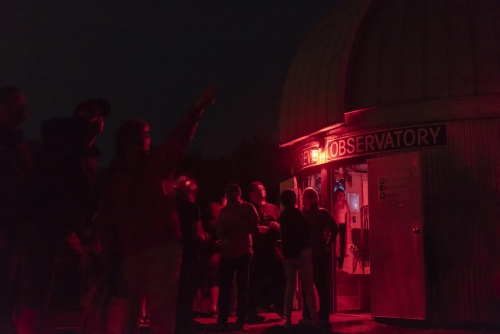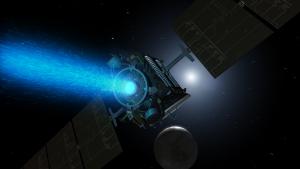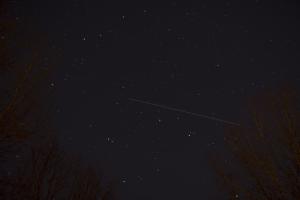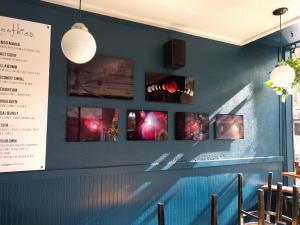
Stargazing Nights
- Where:
- Frosty Drew Observatory
- When:
- Friday November 2, 2018 at 7:00 - 9:00 p.m
- Cost:
- $5 Suggested Donation per person 5 years and older
Tonight is Stargazing Night at Frosty Drew Observatory and sadly enough, rain, t-storms, full cloud cover, patchy dense fog, and high winds are all in tonight’s forecast. This leaves us with no chance of viewing the sky tonight in our telescopes. It is rather unfortunate because the Moon has been departing the night sky, with only a 19% waning crescent rising at 2:37 a.m., which would have left super dark skies for us to celebrate. So we will offer our indoor program tonight instead.
We will open the Sky Theatre from 7:00 p.m. - 9:00 p.m. tonight. On screen we will feature our showcase of celestial objects photographed at Frosty Drew Observatory while offering a commentary and hosting an open discussion on general astronomy.
Overall, tonight is certainly not the night to make the long drive. The dastardly forecast will guarantee that telescopes remain closed. High winds and the threat of lightning strikes will also keep the Observatory building closed. If you’re in the local area and want to catch up a bit on your astro, then stop in for a chat about all that happening in the cosmos. Otherwise, stay in with a cup of toasty awesome and weather the storm.
--------------------
Weekly Happenings
Scott MacNeill
On Sunday, November 4, 2018 at 2:00 a.m., all who are on non-permanent Daylight Savings Time (DST) will switch back to Local Standard Time (EST for us in the Northeast). The switch will give us an extra hour of sleep on Saturday night, or an extra hour to be out observing the night sky, though we will not see an extra hour of darkness. For those unsure of which way to switch the clocks, here is a good mnemonic: “In the Fall, fall back one hour. In the Spring, spring ahead one hour.” Enjoy your extra hour this weekend, in the best way that works for you!
Now that the Moon is departing the night sky, it is time to get out and look for fireball meteors, compliments of the Taurid Meteor Showers. The Taurid showers are a result of Comet 2P/Encke, which is a periodic comet that orbits the Sun once every 3.3 years. As Comet Encke orbits the Sun, it crosses Earth’s orbit, leaving behind a trail of tiny rice-grain-sized pieces of ice and rock. Earth will orbit into this debris field every year and encounter these tiny pieces of comet, which get caught in Earth’s gravity and enter Earth’s atmosphere at speeds of 17 miles per second and burn up. Due to Jupiter’s gravitational affects on Comet Encke, the debris field left by the comet is scattered across two branches, which give us two Taurid Meteor Showers each year. The South Taurids (Oct 28 peak), and the North Taurids (Nov 10 peak). The Taurid peaks are nothing spectacular, with only an increase of about 5 meteors per hour. What makes the Taurids notable, is the number of fireball meteors the showers bring, which are brighter and longer lasting than average meteors. The weeks around the peak nights will bring this fireball increase. The periods of the night with no Moon are when you want to be out. Considering that the Orionid Meteor Shower is still active, you will certainly have a few meteors per hour to see. Saturday night this weekend, looks fabulous for meteor spotting. So get out to a dark location with a wide open view of the sky, lay on your back, and celebrate the return to Standard Time with a night of meteor watching.
On Wednesday, October 31, 2018, the NASA Dawn spacecraft, which is in orbit around dwarf planet, Ceres, failed to radio home. The Dawn spacecraft has already completed its extensive mission and is setup to remain in orbit around Ceres for potentially the next 50 years. The spacecraft has been running increasingly low on fuel, and this loss of communication indicates that the lil chick has finally run out of fuel and can no longer maintain pointing stability in aligning its antenna with Earth. The Dawn mission launched in 2007 and visit two solar system bodies; Vesta, the second largest object in the Asteroid Belt, and dwarf planet Ceres, the largest object in the Asteroid Belt. Thanks to Dawn, we have a fabulous up close vantage point of Vesta and Ceres and have learned an intense amount about the history of the Solar System. The data sets that have come back from Dawn over the years are massive, and hidden discoveries lurking in the data will continue the legacy of this fabulous mission for years to come. Take a moment today to visit the Dawn mission page and catch up on all the amazing things this little spacecraft has done. Way to go Dawn!
Tiangong 2, China’s current space station, continues to offer up fabulous visible passes overhead, daily. You need clear(er) skies to catch sight of the Chinese station, and though it’s not as bright as the International Space Station (ISS), passes are still fabulous to observe. Here are the most notable passes happening over the next few nights:
• Nov 2: starting at 7:23 p.m. in the W, rising to 61° and into Earth’s shadow (orbital sunset)
• Nov 3: starting at 6:25 p.m. in the W, rising to 72°, heading towards ENE
• Nov 4: starting at 6:03 p.m. in the W, rising to 67° and into Earth’s shadow (orbital sunset)
• Nov 6: starting at 5:43 p.m. in the WNW, rising to 80°, heading towards E
• Nov 7: starting at 6:21 p.m. in the W, rising to 49° and into Earth’s shadow (orbital sunset)
• Nov 8: starting at 5:23 p.m. in the WNW, rising to 75°, heading towards ESE
If you’re in the Providence, Rhode Island area from now until December 18th, stop in at Amys Place on Wickenden Street. The cafe will be showcasing a gallery of celestial photographs that I capture at Frosty Drew Observatory. They have breakfast all day and fabulous smoothies. So stop in for a little treat and check out the view.
-Scott




